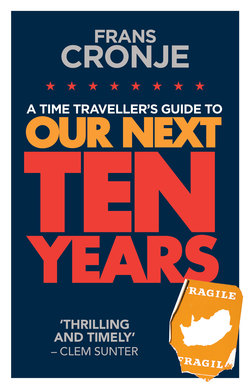Читать книгу A Time Traveller's Guide to Our Next Ten Years - Frans Cronje - Страница 17
На сайте Литреса книга снята с продажи.
STEP 10 Write the scenarios
ОглавлениеThe tenth and final step is to write out the final scenarios. The scenarios in the four quadrants of the scenario matrix are outlines, or wire frames, of four possible futures, based on the interplay of the two most important and most uncertain trends.
In order to turn these outlines into fully fledged scenarios, we now need to flesh them out by adding the impacts of all the other trend highways identified in step 6, as well as some of the road signs and route markers identified in step 7, until this particular future comes alive and forms a coherent whole. In Schwartz’s terminology, each key driving force must be incorporated into each scenario framework, and the practitioner must now ‘weave the pieces together to form a narrative’,[9] comprising a description of a certain future.
The idea here is to suspend disbelief, imagine that you are standing in each of these broad futures, and create a fleshed-out version of this future, taking into account all the other trends, as well as how this future developed over time, emphasising vital points of divergence with the other futures. This is similar to describing Nelson Mandela’s inauguration as president on the day it occurred by recounting the train of events that brought the country to this point since PW Botha’s Rubicon speech in 1985. The only difference is that you would be writing this description the morning after the Rubicon speech – a decade before Mandela was inaugurated.
To an extent, one is engaging in some kind of research-based time travel – hence the title of this book. When this is done effectively, it gives readers an almost magical sense of standing in that future and looking back at the present, with the highways behind them, and the road signs and markers showing them how they got here over time.
Given this, we now need to get started with the actual scenario building process and determine whether South Africans are content with the status quo or whether there is growing demand for radical economic, social and political change. Should we uncover that South Africans are not satisfied with the current situation, we have to ask, what, if anything, they can do to bring about fundamental change in the country.
